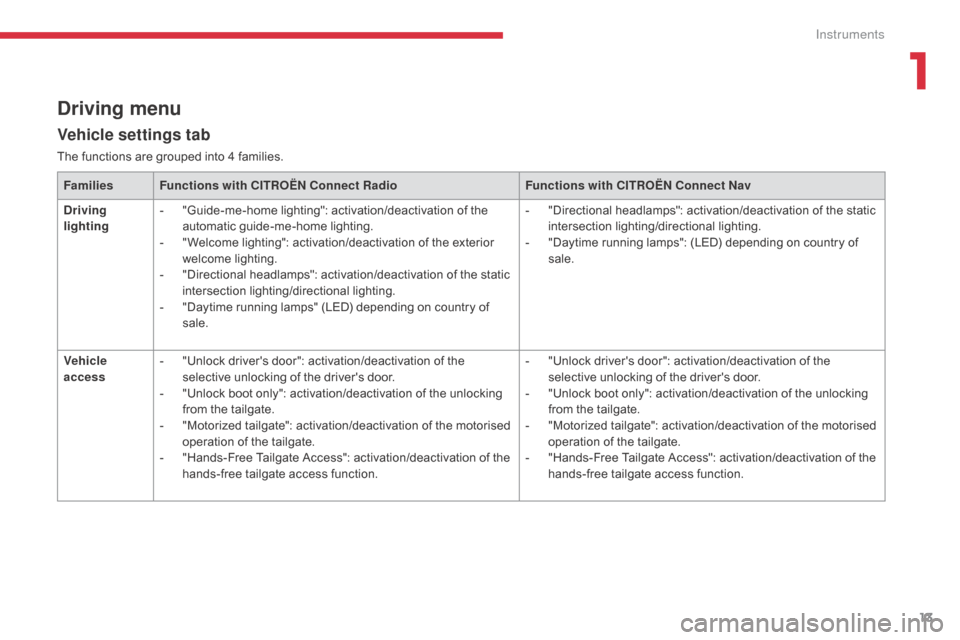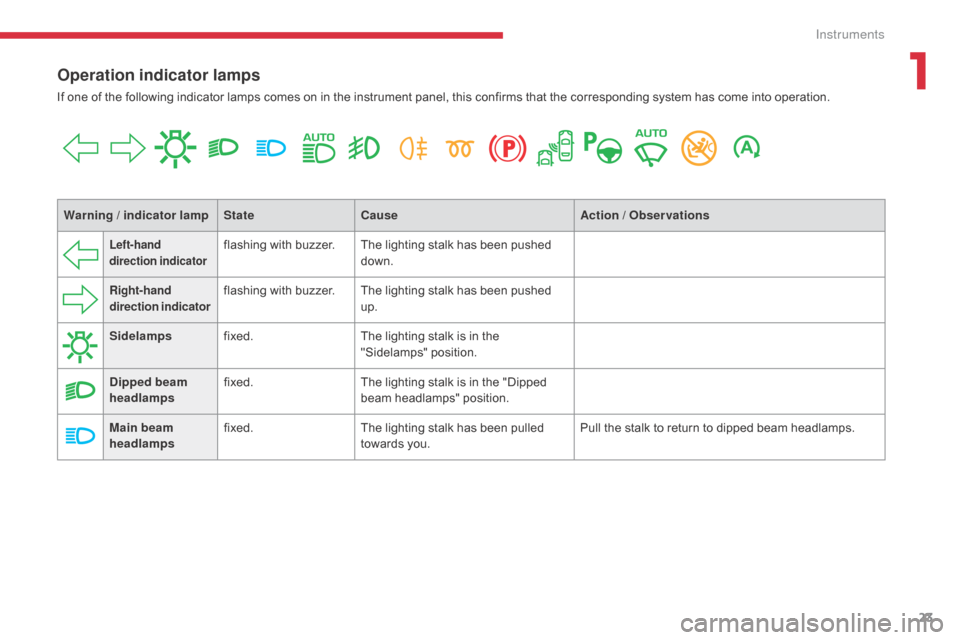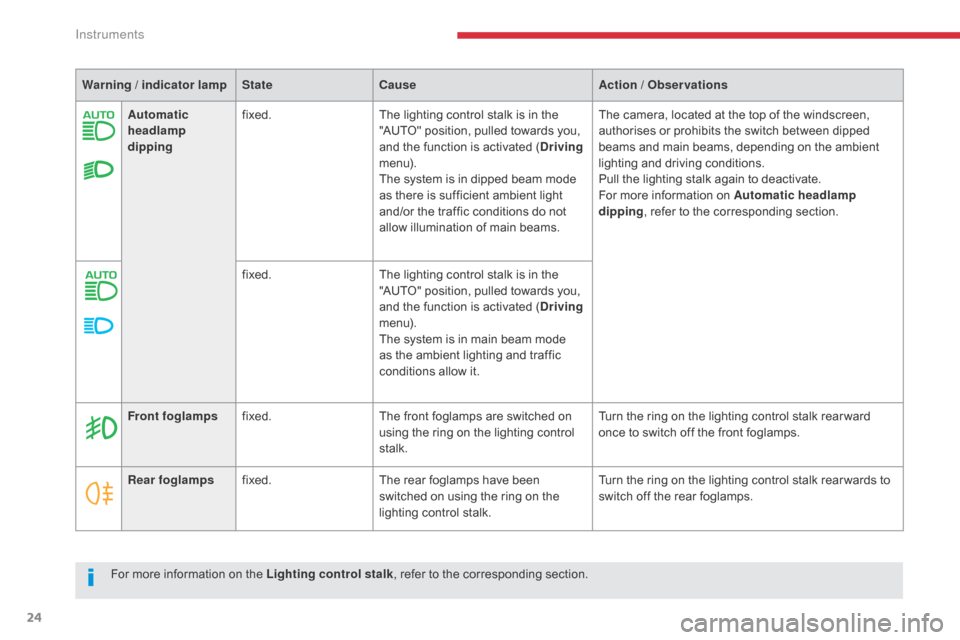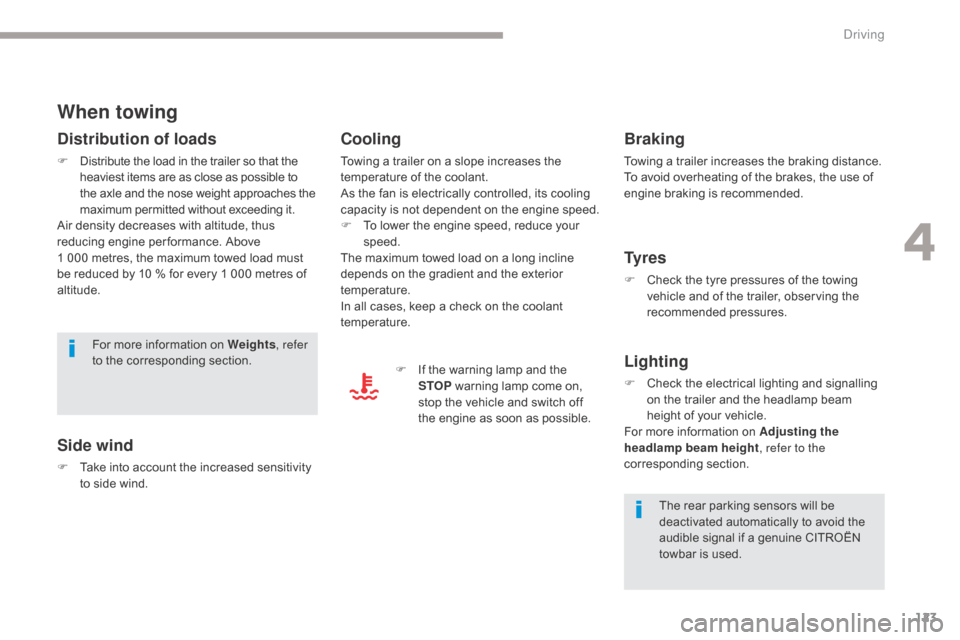headlamp Citroen GRAND C4 PICASSO RHD 2017 2.G Owner's Manual
[x] Cancel search | Manufacturer: CITROEN, Model Year: 2017, Model line: GRAND C4 PICASSO RHD, Model: Citroen GRAND C4 PICASSO RHD 2017 2.GPages: 523, PDF Size: 11.96 MB
Page 5 of 523

General safety recommendations 226
Hazard warning lamps
2
27
Horn
2
27
Emergency or assistance
2
28
Electronic stability control (ESC)
2
30
Seat belts
23
3
Airbags
2
38
Child seats
2
42
Deactivating the passenger's front airbag
2
44
ISOFIX mountings
2
51
Child lock
2
58
Safety
Fuel 2 59
Misfuel prevention (Diesel)
2
60
Snow chains
2
62
Very cold climate screen(s)
2
63
Towbar with quickly detachable towball
2
64
Towing a trailer
2
66
Energy economy mode
2
67
Changing a wiper blade
2
68
Roof bars
2
69
B o nnet
2
71
Petrol engines
2
72
Diesel engines
2
73
Checking levels
2
74
Checks
2
77
AdBlue
® additive and SCR system
(BlueHDi Diesel) 2 79
Practical information
Warning triangle 2 83
Temporary puncture repair kit
2
84
Spare wheel
2
91
Changing a bulb
3
01
Changing a fuse
3
10
12 V battery
3
15
To w i n g
3
19
Running out of fuel (Diesel)
3
21
In the event of a breakdown
Petrol engines 322
Petrol weights
3
24
Diesel engines
3
26
Diesel weights
3
28
Dimensions
3
30
Identification markings
3
31
Technical data
Mirrors 205
Lighting control stalk
2
08
Automatic illumination of headlamps
2
13
Automatic headlamp dipping
2
14
Daytime running lamps
2
16
Direction indicators
2
17
Adjusting the headlamp beam height
2
17
Directional lighting
2
19
Wiper control stalk
2
20
Screenwash
2
22
Automatic rain sensitive wipers
2
23
Panoramic sunroof
2
25
Lighting and visibility Alphabetical index
For the audio and telematic systems,
refer to the supplement to the handbook
or go to the following internet address:
http://service.citroen.com/ddb/
Contents
Page 6 of 523

4
Exterior
Fuel tank, misfuel prevention 259 -261
Wipers, screenwash
2
20 -224
Changing a wiper blade
2
68
Exterior welcome lighting
2
16 -217
Door mirror spotlamps
2
16
Cornering lighting
2
18
Directional lighting
2
19
Adjusting the headlamp beam height 217
Changing bulbs 3
01-305
-
f
ront lamps
-
fo
glamps
-
d
irection indicator repeaters
Very cold climate screen(s)
2
63
Door mirrors
2
05 -206
Panoramic sunroof
2
25
Roof bars
2
69
ESC: ABS, EBFD, EBA, ASR, DSC
23
0-232
Tyre under-inflation detection
2
02-204
Tyre pressures
3
31
Temporary puncture repair kit
2
84-290
Changing a wheel
2
91-300
-
tools
-
spar
e wheel
-
r
emoving / refitting
Snow chains
2
62
Changing bulbs
3
05-309
-
r
ear lamps
-
3rd brake lamp
-
n
umber plate lamps
-
fo
glamps
Parking sensors
1
89 -190
Reversing camera
1
91
360 Vision
1
92-193
Park Assist
1
94-201
Towbar
1
23, 266
Towing (advice)
3
19 -320
Towbar with quickly detachable towball
2
64-265
Boot
6
4-70
-
o
pening / closing
-
b
ack-up release
Motorised tailgate
6
5 - 68
Hands-free tailgate
6
9 -70
Electronic key / "Keyless Entry and
Starting" system
5
3 - 60
-
o
pening / closing
-
a
nti-theft protection
-
em
ergency procedure
-
battery
Doors
6
2- 63
-
o
pening / closing
-
em
ergency control
Central locking
6
1
Alarm
7
1-73
Electric windows
7
4-75
Over view
Page 9 of 523

7
Hazard warning lamps 227Adjusting the headlamp beam height 217
Steering wheel adjustment
9
3
Horn
2
27
START/STOP button
1
24-129
Wiper and screenwash controls 220-224
Trip computer
4 9 -51
Lighting controls
2
08 -217
Direction indicators
2
17
Instruments and controls (cont.)
Memorising speeds 1 48
Speed limit recognition 1 49-152
Speed limiter
1
53 -155
Cruise control
1
56 -158
Dynamic cruise control
1
59 -165
Dynamic cruise control with Stop function
1
66-174
Collision Risk Alert and Active Safety Brake
1
75 -179
Inter-vehicle distance
1
67, 170
Black panel
4
8
Modes
2
0 -21
.
Over view
Page 11 of 523

9
Optimise the use of your gearbox
With a manual gearbox, move off gently and change up without waiting.
During acceleration change up early.
With an automatic gearbox, give preference to automatic mode and
avoid pressing the accelerator pedal heavily or suddenly.
Control the use of your electrical
equipment
Before moving off, if the passenger compartment is too warm,
ventilate it by opening the windows and air vents before using the air
conditioning.
Above 30 mph (50 km/h), close the windows and leave the air vents
open.
Remember to make use of equipment that can help keep the temperature
in the passenger compartment down (sunroof and window blinds...).
Switch off the air conditioning, unless it has automatic regulation, as
soon as the desired temperature is attained.
Switch off the demisting and defrosting controls, if not automatic.
Switch off the heated seat as soon as possible.
Switch off the headlamps and front foglamps when the ambient light
level does not require their use.
Avoid running the engine before moving off, particularly in winter; your
vehicle will warm up much faster while driving.
As a passenger, if you avoid connecting your multimedia devices
(film, music, video game...), you will contribute towards limiting the
consumption of electrical energy, and so of fuel.
Disconnect your portable devices before leaving the vehicle.
Eco-driving
Eco-driving is a range of everyday practices that allow the motorist to optimise their fuel consumption and CO2 emissions.
Drive smoothly
Maintain a safe distance between vehicles, use engine braking rather
than the brake pedal, and press the accelerator progressively. These
practices contribute towards a reduction in fuel consumption and
CO
2 emissions and also help reduce the background traffic noise.
I
f your vehicle has cruise control, make use of the system at speeds
above 25 mph (40 km/h) when the traffic is flowing well. The gear efficiency indicator invites you to engage the most suitable
gear: as soon as the indication is displayed in the instrument panel,
follow it straight away.
For vehicles fitted with an automatic gearbox, this indicator appears
only in manual mode.
.
Eco-driving
Page 15 of 523

13
Driving menu
Vehicle settings tab
The functions are grouped into 4 families.Families Functions with CITROËN Connect Radio Functions with CITROËN Connect Nav
Driving
lighting -
"
Guide-me-home lighting": activation/deactivation of the
automatic guide-me-home lighting.
-
"
Welcome lighting": activation/deactivation of the exterior
welcome lighting.
-
"
Directional headlamps": activation/deactivation of the static
intersection lighting/directional lighting.
-
"
Daytime running lamps" (LED) depending on country of
sale. -
"
Directional headlamps": activation/deactivation of the static
intersection lighting/directional lighting.
-
"
Daytime running lamps": (LED) depending on country of
sale.
Vehicle
access -
"
Unlock driver's door": activation/deactivation of the
selective unlocking of the driver's door.
-
"
Unlock boot only": activation/deactivation of the unlocking
from the tailgate.
-
"
Motorized tailgate": activation/deactivation of the motorised
operation of the tailgate.
-
"
Hands-Free Tailgate Access": activation/deactivation of the
hands-free tailgate access function. -
"
Unlock driver's door": activation/deactivation of the
selective unlocking of the driver's door.
-
"
Unlock boot only": activation/deactivation of the unlocking
from the tailgate.
-
"
Motorized tailgate": activation/deactivation of the motorised
operation of the tailgate.
-
"
Hands-Free Tailgate Access": activation/deactivation of the
hands-free tailgate access function.
1
Instruments
Page 17 of 523

15
Driving function tab
Corresponding functionComments
Adjusting Speeds Memorisation of speed settings for the speed limiter, cruise control or dynamic cruise control.
Under-inflation initialization Reinitialisation of the under-inflation system.
Diagnostic List of current alerts.
Help with changing lane Activation/deactivation of the "active lane departure warning" function.
Parking sensors Activation/deactivation of the function.
Automatic headlamp dipping Activation/deactivation of the "Automatic headlamps" function.
Stop & Star t Activation/deactivation of the function.
Blind spot sensors Activation/deactivation of the function.
Panoramic visual aid Activation/deactivation of the function then choice of options.
Cruise control active Choice of the standard cruise control or the dynamic cruise control.
Traction control Activation/deactivation of the function.
For more information on one of these functions, refer to the corresponding section.
1
Instruments
Page 25 of 523

23
Operation indicator lamps
If one of the following indicator lamps comes on in the instrument panel, this confirms that the corresponding system has come into operation.Warning / indicator lamp StateCause Action / Observations
Left-hand
direction indicatorflashing with buzzer.The lighting stalk has been pushed
down.
Right-hand
direction indicatorflashing with buzzer.The lighting stalk has been pushed
up.
Sidelamps fixed. The lighting stalk is in the
"Sidelamps" position.
Dipped beam
headlamps fixed.
The lighting stalk is in the "Dipped
beam headlamps" position.
Main beam
headlamps fixed.
The lighting stalk has been pulled
towards you. Pull the stalk to return to dipped beam headlamps.
1
Instruments
Page 26 of 523

24
Automatic
headlamp
dippingfixed.
The lighting control stalk is in the
"AUTO" position, pulled towards you,
and the function is activated ( Driving
m e n u).
The system is in dipped beam mode
as there is sufficient ambient light
and/or the traffic conditions do not
allow illumination of main beams. The camera, located at the top of the windscreen,
authorises or prohibits the switch between dipped
beams and main beams, depending on the ambient
lighting and driving conditions.
Pull the lighting stalk again to deactivate.
For more information on Automatic headlamp
dipping
, refer to the corresponding section.
fixed. The lighting control stalk is in the
"AUTO" position, pulled towards you,
and the function is activated ( Driving
m e n u).
The system is in main beam mode
as the ambient lighting and traffic
conditions allow it.
Warning / indicator lamp
StateCause Action / Observations
Rear foglamps fixed. The rear foglamps have been
switched on using the ring on the
lighting control stalk. Turn the ring on the lighting control stalk rear wards to
switch off the rear foglamps.
Front foglamps
fixed. The front foglamps are switched on
using the ring on the lighting control
stalk. Turn the ring on the lighting control stalk rear ward
once to switch off the front foglamps.
For more information on the Lighting control stalk , refer to the corresponding section.
Instruments
Page 36 of 523

34
Warning / indicator lampStateCause Action / Observations
Battery charge fixed. The battery charging circuit has a
fault (dirty or loose terminals, slack or
cut alternator belt,
...).The warning lamp should go off when the engine is
started.
If it does not go off, contact a CITROËN dealer or a
qualified workshop.
Maximum
coolant
temperature fixed.
The temperature of the cooling
system is too high. Stop as soon as it is safe to do so.
Wait until the engine has cooled down before topping-
up the level, if necessary.
If the problem persists, contact a CITROËN dealer or
qualified workshop.
Directional
headlamps
flashing.
The directional headlamps system
has a fault. Have it checked by a CITROËN dealer or a qualified
workshop.
Door(s) open * fixed, associated with
a message identifying
the door. A door or the boot is still open and
the speed is lower than 6 mph
(10
km/h).Close the door or the boot.
fixed, associated with a
message identifying the
door and accompanied
by an audible signal.A door or the boot is still open and
the speed is higher than 6 mph
(10
km/h).
* Only with the monochrome digital instrument panel. Engine oil
pressure
fixed.
There is a fault with the engine
lubrication system. You must stop as soon it is safe to do so.
Park, switch off the ignition and contact a CITROËN
dealer or a qualified workshop.
Instruments
Page 125 of 523

123
When towing
Distribution of loads
F Distribute the load in the trailer so that the heaviest items are as close as possible to
the axle and the nose weight approaches the
maximum permitted without exceeding it.
Air density decreases with altitude, thus
reducing engine per formance. Above
1
000 metres, the maximum towed load must
be reduced by 10
% for every 1 000 metres of
altitude.
Side wind
F Take into account the increased sensitivity to side wind.For more information on Weights
, refer
to the corresponding section.
The rear parking sensors will be
deactivated automatically to avoid the
audible signal if a genuine CITROËN
towbar is used.
Cooling
Towing a trailer on a slope increases the
temperature of the coolant.
As the fan is electrically controlled, its cooling
capacity is not dependent on the engine speed.
F
T
o lower the engine speed, reduce your
speed.
The maximum towed load on a long incline
depends on the gradient and the exterior
temperature.
In all cases, keep a check on the coolant
temperature.
F
I
f the warning lamp and the
STOP warning lamp come on,
stop the vehicle and switch off
the engine as soon as possible.
Braking
Towing a trailer increases the braking distance.
To avoid overheating of the brakes, the use of
engine braking is recommended.
Ty r e s
F Check the tyre pressures of the towing vehicle and of the trailer, observing the
recommended pressures.
Lighting
F Check the electrical lighting and signalling on the trailer and the headlamp beam
height of your vehicle.
For more information on Adjusting the
headlamp beam height , refer to the
corresponding section.
4
Driving